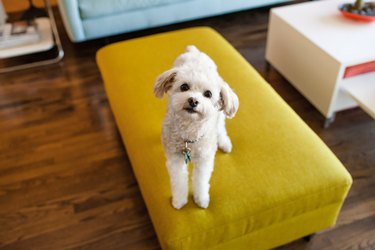
So you've adopted the adult dog or puppy of your dreams! Congratulations! Now what? Bringing a new dog home is an exciting time and it can be tempting to try to do everything at once with your new dog. Especially if your new canine family member came from less-than-ideal circumstances, you might feel a lot of pressure to try to show your new pet how amazing their new life is going to be.
However, trying to do too many things too quickly can be overwhelming for dogs who are just getting used to a new home. Dogs who experience this kind of stress can struggle to adjust to their new homes and family. Here are some adoption tips to help your new family member settle in and become the best dog they can be.
Video of the Day
Video of the Day
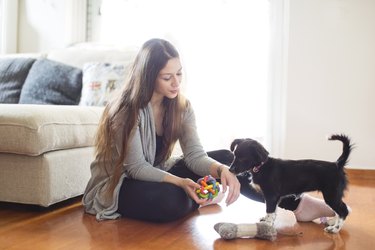
Don’t: overwhelm your new dog
Having a new dog is exciting and it can feel exciting to think about being able to show them everywhere, but instead, it's better to give quiet time to adjust to their new home. This isn't the time for your new dog to meet all your friends and family. First, let your dog get used to you and members of your immediate family before starting to introduce your friends and extended family. It's understandable to want to start doing fun things with your dog, but right after adoption, it's best to avoid taking your dog to any pet shops, dog-friendly outdoor restaurants, and other public places. If your newly adopted dog is social with dogs and people there will be plenty of time for outings like that in the future, but after adoptions, it's best keep things quiet. Bringing your newly adopted dog to busy and stimulating places is overwhelming, can be frightening, and make it harder for your dog to adjust to life in their new home. Exposing your newly adopted dog to stressful and overwhelming experiences can also lead to fear-based behavioral issues like reactivity.

Do: allow decompression time
Instead of being in a rush to bring your newly adopted dog, new places provide your dog time to decompress from the stress of being in a shelter or just the stress of being rehomed. Instead of bringing your dog to pet stores go on your own to get dog supplies or puppy supplies, or have them delivered to your home. Dogs take time to decompress when they are adopted and transitioning to a new home and adapting to their new environment.
Dogs take days, weeks, and even months to fully acclimate to new homes. Many dog professionals have come to understand that acclimating to a new home for most dogs can be best understood with the 3-3-3 rule. This means it (generally) takes three days for a dog to initially stop feeling overwhelmed and start to feel like they are comfortable. It takes three weeks for most newly adopted dogs to start understanding and anticipating a new routine, this is where you may start to see hidden behaviors start to emerge. It then takes about three months after adoption for a dog to really feel at home.
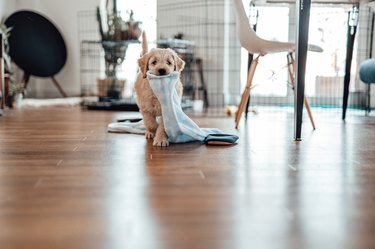
Don’t: give full access to the house yet
When you first bring a new dog home, it can be tempting to want to let them have full access to their new home, but this can present safety issues for your dog. When you adopt a dog, you aren't going to be certain what their experience being inside a home has been, and what normal but potentially destructive dog behaviors they might engage, like chewing.
We want to always strive to set our newly adopted dogs up for success. Giving free access to your entire house might come from a loving place, but it's putting our dog into a situation they likely aren't ready for and where they could hurt themselves. You can ease your dog into having access to the full home after more time has passed and you are more familiar with each other.
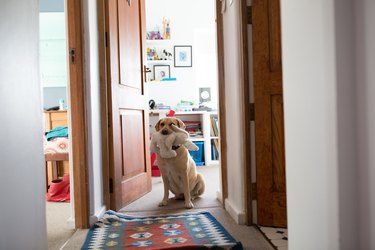
Do: provide a dog-proof area
When you can't fully supervise your newly adopted dog like when you're sleeping, or away at work it's essential to provide your dog with their own safe space. This might look like crate training, or dog-proofing a small room in your house and using doors or baby gates to keep your dog in that area when not supervised. Providing your dog with safe spaces to be can help prevent your dog from eating things that might be toxic, chewing on dangerous electrical cords, or chewing and ingesting household items that could create an obstruction and require emergency surgery. Give your dog things they enjoy like treats, toys, and chews in their safe space to help your new pet build positive associations with their space.
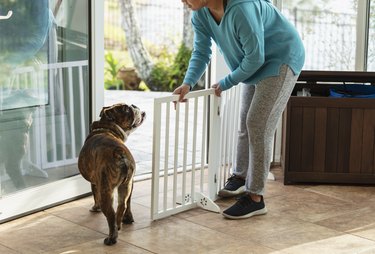
Don’t: assume your new dog is healthy
If you adopt a dog from a rescue or shelter, you're probably going to be given some veterinary records for your new dog. These usually include examination records, and a history of vaccinations given at the shelter or by the rescue, but it doesn't mean your newly adopted dog is necessarily healthy. Most shelters and rescues do the best they can to provide medical care to dogs, but they aren't always able to provide dogs with all the care they are going to need, or fully treat underlying or chronic health conditions like arthritis and allergies.
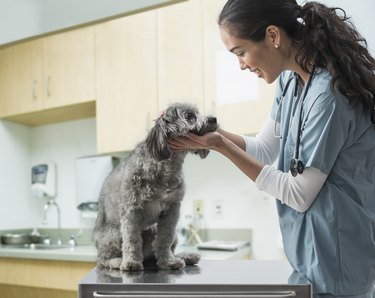
Do: schedule a vet visit
Even if you were given medical records from the shelter or rescue, it's a good idea to schedule an appointment and establish care with your veterinarian. At a wellness appointment, your veterinarian will do a thorough examination of your recently adopted dog to assess overall health. Your vet will also review any medical records you were given by the rescue/shelter and determine if there are any additional vaccines or treatments due at this time. Your vet will also be able to get your dog started on flea/tick, and heartworm preventatives and discuss other preventative care needs your new dog might have.
A veterinary practice that is certified Fear Free is a great option for a newly adopted dog (or any dog). These veterinarians and their staff are trained in methods that cause the lowest amount of fear and stress for pets.
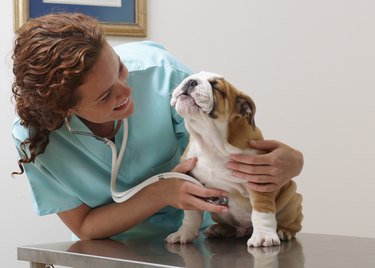
Don’t: prioritize rules
When you bring a new dog home, it can be tempting to try to do everything at once to teach them about the expectations of your home. Remember that your new dog is going through a lot of changes and getting used to being with a new family in a new home. Try to lower your expectations for how your new dog will behave during this time.
It's ok for your newly adopted dog not to be perfectly behaved. There is plenty of time to teach your new dog all the skills you want them to learn once they feel safe, confident, and secure in their new home. When bringing a new dog home, just focus on bonding and keeping them safe. Don't worry about teaching lots of skills, that will come later!

Do: keep training simple
When you bring a new dog home you don't need to worry about teaching complicated skills at this time. Instead, focus on house training, and just spending quality time bonding with your dog.
One quick skill that is useful to start teaching is to make sure your dog knows their name. One way to do this is to have lots of treats, say your newly adopted dog's name, and give your dog a treat. That's it! After a few repetitions, your dog will start to turn towards you anytime you say their name.
When you start to introduce basic training skills to your newly adopted dog, you will want to utilize positive reinforcement training techniques, and leave punishment behind, as punishment-based training methods are outdated now!
Feeling overwhelmed by behaviors you're seeing or not sure where to start? Finding a qualified dog trainer in your area who utilizes positive reinforcement training can help you and your dog better understand each other.
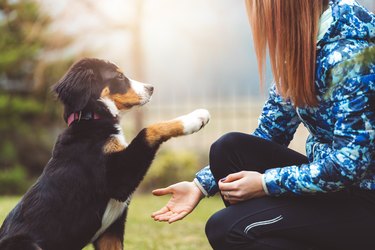
Don’t: allow your dog off leash in public
Safety is the top priority with your newly adopted dog. Even if you have been told that this dog has a good recall (meaning they will come back to you when you say their name or a certain word), it's important to never allow your newly adopted dog off leash while in parks or on hiking trails.
As your new dog is bonding with you and adjusting to being part of your family, you are also still learning about their behavior, quirks, and fears. Letting your dog off leash can put your dog at risk of getting lost or having an altercation with another dog. Similarly, avoid dog parks with your newly adopted dog and instead focus on getting to know your new dog's temperament so you'll know for the future how dog social they are.
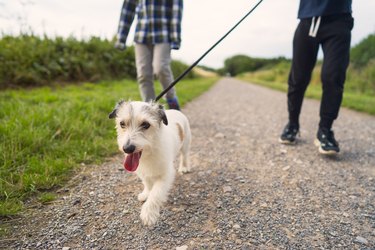
Do: always supervise your dog
When spending time outside with your newly adopted dog it's best to keep your dog on leash. Keeping your dog leashed allows you to keep your dog close to you, and prevent your dog from approaching others, or getting into dangerous situations. If you want to give your newly adopted dog more space, you can use a long-line leash in an open area. This will allow your dog to run and play while still staying connected to you. If you have a fenced yard where you can play with your dog, supervise your dog at all times while they are outside to prevent them from jumping or climbing a fence or digging under.
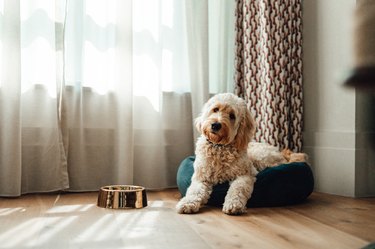
The bottom line
Adopting a new dog is overwhelming, but just remember to give your dog, and yourself, lots of time and patience! Adjust your expectations about the perfect dog and the perfect dog parent. Focus on bonding, patience, and safety for these first few months!